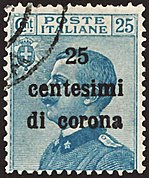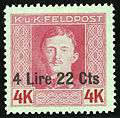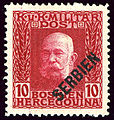Postage stamps and postal history of Austria
You can help expand this article with text translated from the corresponding article in German. (February 2015) Click [show] for important translation instructions.
|
You can help expand this article with text translated from the corresponding article in French. (August 2015) Click [show] for important translation instructions.
|
This article deals with the stamps and postal history of the Austrian Empire, Cisleithania within Austria-Hungary, and the Republic of Austria.
The historical context

The Austrian Empire stamps were first issued on June 1, 1850: a coat of arms under the text KK Post-Stempel.[1] The word Austria does not appear, which is logical, as the issue served in whole central Europe, more precisely in all or in part of the current following countries:
- in the north: the Czech Republic, Slovakia and Poland;
- in the East Ukraine and Romania;
- in the South Serbia, Slovenia, Croatia, Montenegro and the north of Italy;
- Austria and Hungary.
The languages used in the empire were German, Italian, Hungarian, Czech, Serbo-Croat, Polish and French (postmark Chargé).
For a better understanding of the historical context, see the article Austria-Hungary.
Empire (1850-1867) and Dual-Monarchy (1867-1918)

The first
The scarlet Red Mercury (Zinnoberrote Merkur, lit. "vermilion Mercury"), issued on March 21, 1856 is the rarest of the lithographed newspaper stamps authorized on September 12, 1850 which bore Mercury heads but no denominations. The low value blue variety used to frank individual newspapers is the commonest but the higher values in yellow, rose, and scarlet were used on wrappers of bundles of 10 or 50 newspapers and were often discarded.[3]
Franz Josef profiles reappeared in 1867, as a side effect of the establishment of the

1899 also saw the appearance of
In 1908, Austria issued a series of large pictorial stamps, designed by Koloman Moser, to commemorate the 60th year of Franz Josef's reign, depicting previous emperors, Franz Josef at various ages, Schönbrunn Palace, and the Hofburg (both in Vienna). The designs were reused in 1910 for a Birthday Jubilee issue celebrating Franz Josef's 80th birthday, the dates "1830" and "1910" being added at top and bottom.
A series in 1916 depicted Franz Josef, the Austrian crown, and the coat of arms, and between 1917 and 1919 Emperor Charles I briefly made an appearance on stamps before the republic was established.
Austro-German Postal Union
On 6 April 1850 the
First Republic (1918-1938)

The first issues of the Republic of
In 1919 the Republic of Austria issued stamps with new designs; a post horn, the coat of arms, a kneeling man representing the new republic, and the Parliament building, all done in a vaguely Art Nouveau style, and inscribed "DEUTSCHÖSTERREICH" ("ÖSTERREICH" appeared in 1922).

However, Austria was caught in the
In 1925, a new monetary system was introduced, 100
Nazi Germany (1938-1945)

In 1938, Nazi Germany annexed Austria and incorporated its territory, which put a sudden end to Austria's stamps. Although the entry of German troops in March was sudden, the transition of the postal system took several months; and included a period where German stamps were required in addition to Austrian stamps (a mixed franking). After the transition period was over, Austrians used stamps of Germany until the defeat of Nazi Germany in 1945.
Allied occupation (1945)
The wreckage of World War II included the postage stamp production system, and the Allied occupation forces handled the situation in different ways; the Soviets overprinted German stamps before issuing locally printed stamps, while the American/British/French zone used stamps printed in the United States.
In the
New stamps inscribed "REPUBLIK ÖSTERREICH" were issued on 3 July by the Soviet Union, for use in Vienna and surrounding areas, still denominated in German currency.
-
1945 overprint on "Hitler Head" of Germany
-
1945 overprint, handstamped
-
1945 overprint, improved
-
8pf stamp of the Soviet occupation, used in Vienna 2 August 1945
On the other side of occupied Austria, the
Despite the relatively short period of use, almost all of the occupation-related issues are common and inexpensive to collect today.
Second Republic (since 1945)
General issues produced by the
Since that time Austria has issued a steady stream of stamps with a variety of subjects, many of them attractively engraved.
Lombardy-Venetia

Because of the early date and limited area, all Lombardy-Venetia stamps are uncommon, especially unused, the cheapest costing US$3 or so. The rarest type of newspaper tax stamp last sold for US$100,000.[citation needed]
Italian occupation

Near the end of
Austrian post offices abroad
During the 19th and early 20th centuries Austria maintained post offices in the
):Military post
Austria-Hungary issued stamps named Feldpost (
-
Austro-Hungarian military stamp for use in occupied Italian territories, 1918
-
Austro-Hungarian military stamp for use in Montenegro, 1917
-
Austro-Hungarian military stamp for use in occupied Romanian territories, 1917
-
Austro-Hungarian military stamp for use in Serbia, 1916
Postal stationery

The first items of postal stationery to be issued by Austria were envelopes Briefumschlägen in 1861 followed by postal cards Korrespondenzkarten in 1869 and wrappers in 1872. The concept of Korrespondenzkarten has been invented in 1869 by Emanuel Herrmann.[6] They have been printed in 8 languages.
See also
- Edwin Müller
- list of people on stamps of Austria
- Marcophily
- Postal history of Hungary
References and sources
- Notes
- ^ KK is German letters for Imperial and Royal. The Habsburgs were indeed Emperor and Kings.
- ^ "Austria; Saturday, June 1, 1850". First Issues Collectors Club. 2003-11-08. Retrieved 2008-11-29.
- ISBN 0-89192-435-3. Archived from the originalon 2014-03-16.
- ^ The Austro-German Postal Union of 1850
- ^ Mueller 1961 Introduction p.XII
- ^ Österreich 1850-1918, Spezialkatalog und Handbuch, von Dr. Ulrich FERCHENBAUER, Wien 1981, p.503
- ^ Higgins & Gage World Postal Stationery Catalog
- Sources
- Stanley Gibbons Ltd: various catalogues
- Tranmer, Keith, The Postal History of Austria 1938-1946, Austrian Stamp Club of Great Britain, 1972
- Encyclopaedia of Postal History
- Rossiter, Stuart & Fowler, John (1991). World History Stamp Atlas (reprint ed.). Black Cat. ISBN 0-7481-0309-0.
- Zinsmeister, Marian Carne (2006) [1949]. Austrian Stamps and Their Background 1850-1937. reprint by Kessinger Publishing. ISBN 1-4286-6225-1.








